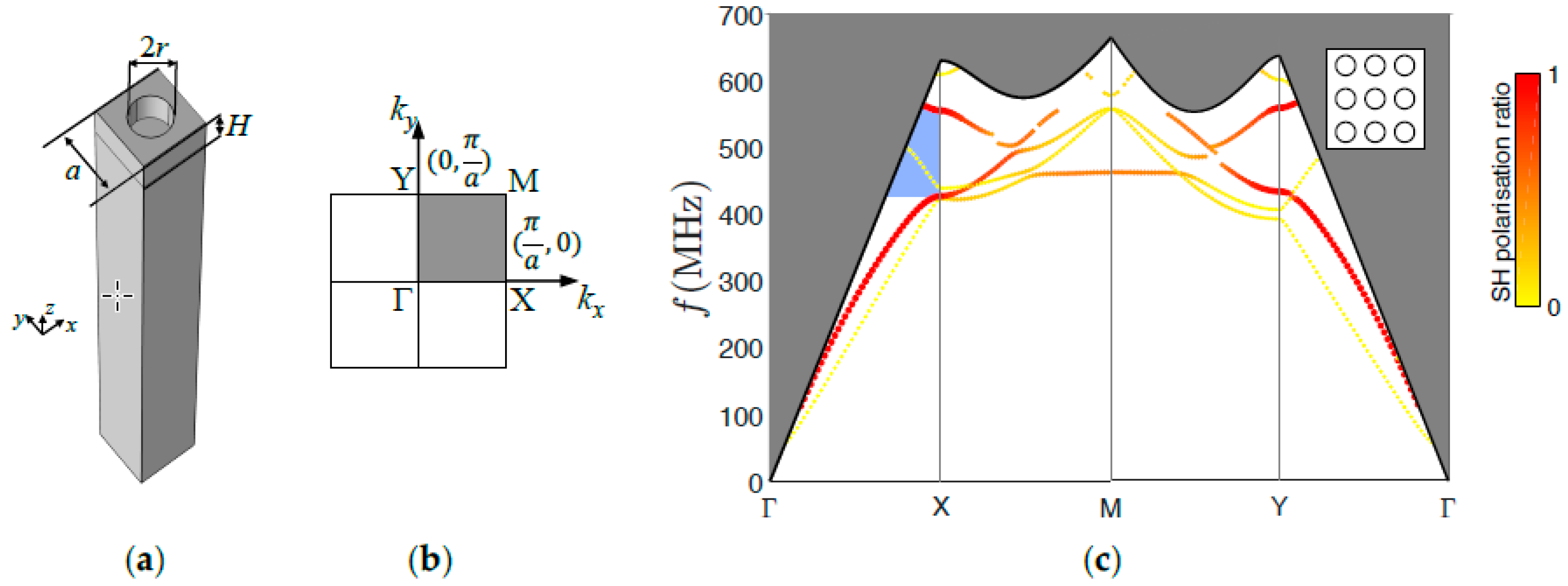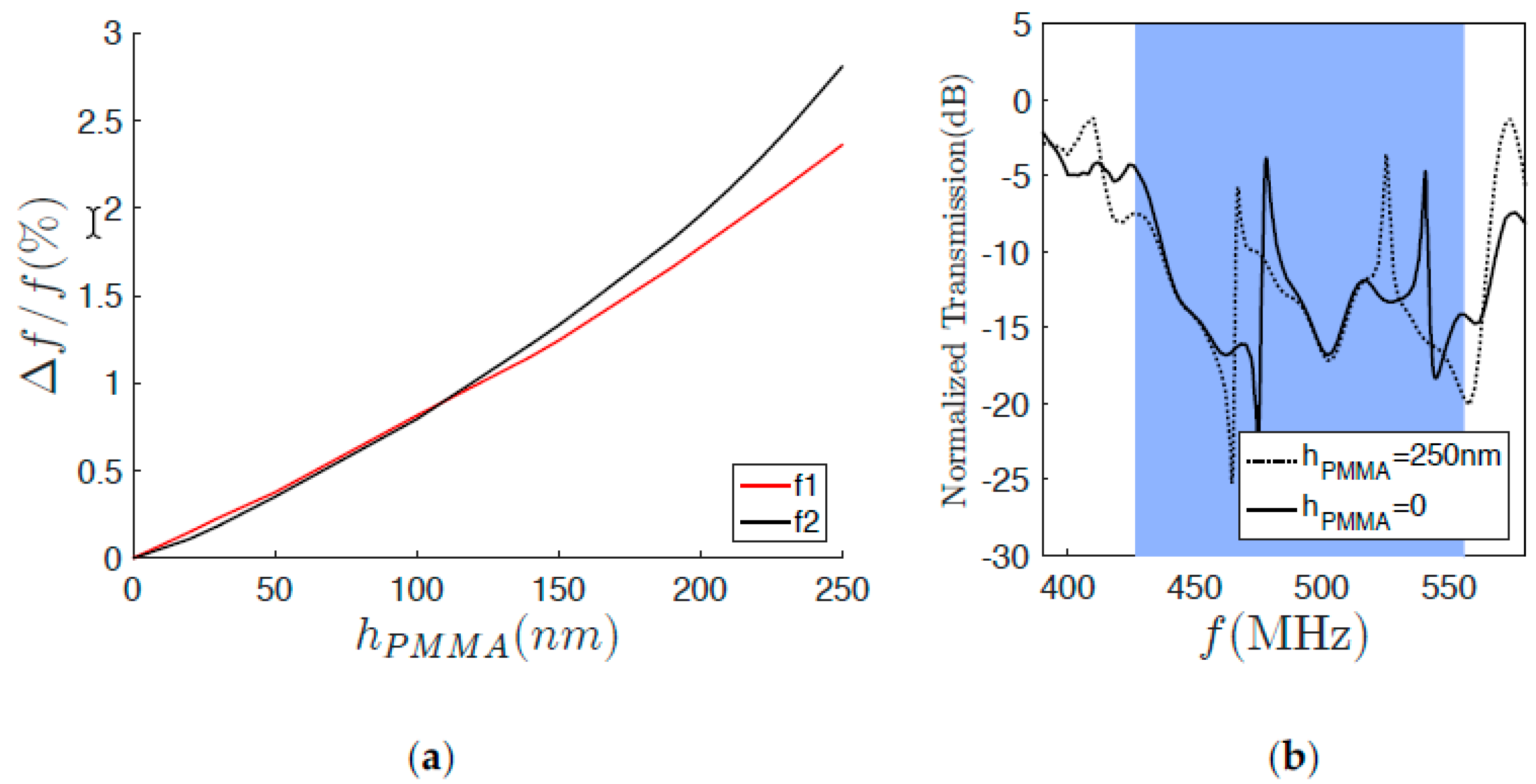Highly Confined Love Waves Modes by Defects States in a Phononic Crystal Based on Holey-SiO2/ST-Cut Quartz Structure †
Abstract
:1. Introduction
2. Materials and Methods
3. Results and Discussion
4. Conclusions
Conflicts of Interest
References
- Khelif, A.; Choujaa, A.; Benchabane, S.; Djafari-Rouhani, B.; Laude, V. Experimental study of guiding and filtering of acoustic waves in a two dimensional ultrasonic crystal. Z. Krist. 2005, 220, 836–840. [Google Scholar] [CrossRef]
- Jin, Y.; Fernez, N.; Pennec, Y.; Bonello, B.; Moiseyenko, R.P.; Hémon, S.; Pan, Y.; Djafari-Rouhani, B. Tunable waveguide and cavity in a phononic crystal plate by controlling whispering-gallery modes in hollow pillars. Phys. Rev. B 2016, 93, 054109. [Google Scholar] [CrossRef]
- Pennec, Y.; Djafari-Rouhani, B.; Vasseur, J.O.; Larabi, H.; Khelif, A.; Choujaa, A.; Benchabane, S.; Laude, V. Acoustic channel drop tunneling in a phononic crystal. Appl. Phys. Lett. 2005, 87, 261912. [Google Scholar] [CrossRef]
- Lucklum, R.; Li, J. Phononic crystals for liquid sensor applications. Meas. Sci. Technol. 2009, 20, 124014. [Google Scholar] [CrossRef]
- Ke, M.; Zubtsov, M.; Lucklum, R. Sub-wavelength phononic crystal liquid sensor. J. Appl. Phys. 2011, 110, 026101. [Google Scholar] [CrossRef]
- Liu, T.-W.; Tsai, Y.-C.; Lin, Y.-C.; Ono, T.; Tanaka, S.; Wu, T.-T. Design and fabrication of a phononic-crystal-based Love wave resonator in GHz range. AIP Adv. 2014, 4, 124201. [Google Scholar] [CrossRef]



Publisher’s Note: MDPI stays neutral with regard to jurisdictional claims in published maps and institutional affiliations. |
© 2018 by the authors. Licensee MDPI, Basel, Switzerland. This article is an open access article distributed under the terms and conditions of the Creative Commons Attribution (CC BY) license (https://creativecommons.org/licenses/by/4.0/).
Share and Cite
Liu, Y.-X.; Talbi, A.; Pernod, P.; Matar, O.B. Highly Confined Love Waves Modes by Defects States in a Phononic Crystal Based on Holey-SiO2/ST-Cut Quartz Structure. Proceedings 2018, 2, 729. https://doi.org/10.3390/proceedings2130729
Liu Y-X, Talbi A, Pernod P, Matar OB. Highly Confined Love Waves Modes by Defects States in a Phononic Crystal Based on Holey-SiO2/ST-Cut Quartz Structure. Proceedings. 2018; 2(13):729. https://doi.org/10.3390/proceedings2130729
Chicago/Turabian StyleLiu, Yu-Xin, Abdelkrim Talbi, Philippe Pernod, and Olivier Bou Matar. 2018. "Highly Confined Love Waves Modes by Defects States in a Phononic Crystal Based on Holey-SiO2/ST-Cut Quartz Structure" Proceedings 2, no. 13: 729. https://doi.org/10.3390/proceedings2130729
APA StyleLiu, Y.-X., Talbi, A., Pernod, P., & Matar, O. B. (2018). Highly Confined Love Waves Modes by Defects States in a Phononic Crystal Based on Holey-SiO2/ST-Cut Quartz Structure. Proceedings, 2(13), 729. https://doi.org/10.3390/proceedings2130729




